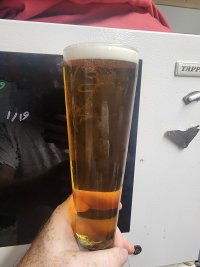rtstrider
Well-Known Member
- Joined
- Dec 12, 2016
- Messages
- 1,310
- Reaction score
- 847
Hey all! Ive been searching for some resources, and real life experiences for wlp925. So far I've come up with quite a few dead ends and generic posts of...Yeah it's good for quick lager turn around. Well...I'd like to get a thread started to share my current experiences with this strain and see what other experiences everyone else has had. I'll go first
WLP925 is an absolute beast of a yeast strain! It freezes well (with a glycerin mix) and propagates fast! I decided to step up this yeast and learn the strain using the Omega Lutra Helles recipe. This was fermented at 62F under 15 psi pressure. I will say this first pitch did finish by day 7 but it took a few weeks of lagering, with gelatin, to hit it's stride. The best way I can describe the initial impressions from this strain would be a warm fermented w34/70 (or variant). Theres a particularly assertive/sharp nose/flavor that I pull from that strain warm fermented. This had what I would call that signature originally but it has aged out now at 3 weeks.
Moving on I brewed a batch of Yoopers Fizzy Yellow beer and racked that straight onto the wlp925 yeast cake. This was also fermented at 15psi/62f. This batch was done on day 4 and ready for cold crash. This was cold crashed for 3 days then kegged/fined with gelatin. The attached picture is day 14 from brew day. This also had that assertiveness on the nose/palate. However that went away after a few pours.
One common theme on these two batches so far is there is a nice, lemony, undertone. Very similar to what you might get from w34/70.
With that said I am now on batch 3 and am fermenting at 50F/15psi stepping up 3F every 24 hours until this hits 68F. This is a dry hopped pilsner and Im really curious to see how this one turns out! I really feel this strain would make a great house continental pilsner strain more so than something on the maltier side. I will report back after batch 3 so there's more data
WLP925 is an absolute beast of a yeast strain! It freezes well (with a glycerin mix) and propagates fast! I decided to step up this yeast and learn the strain using the Omega Lutra Helles recipe. This was fermented at 62F under 15 psi pressure. I will say this first pitch did finish by day 7 but it took a few weeks of lagering, with gelatin, to hit it's stride. The best way I can describe the initial impressions from this strain would be a warm fermented w34/70 (or variant). Theres a particularly assertive/sharp nose/flavor that I pull from that strain warm fermented. This had what I would call that signature originally but it has aged out now at 3 weeks.
Moving on I brewed a batch of Yoopers Fizzy Yellow beer and racked that straight onto the wlp925 yeast cake. This was also fermented at 15psi/62f. This batch was done on day 4 and ready for cold crash. This was cold crashed for 3 days then kegged/fined with gelatin. The attached picture is day 14 from brew day. This also had that assertiveness on the nose/palate. However that went away after a few pours.
One common theme on these two batches so far is there is a nice, lemony, undertone. Very similar to what you might get from w34/70.
With that said I am now on batch 3 and am fermenting at 50F/15psi stepping up 3F every 24 hours until this hits 68F. This is a dry hopped pilsner and Im really curious to see how this one turns out! I really feel this strain would make a great house continental pilsner strain more so than something on the maltier side. I will report back after batch 3 so there's more data

























![Craft A Brew - Safale S-04 Dry Yeast - Fermentis - English Ale Dry Yeast - For English and American Ales and Hard Apple Ciders - Ingredients for Home Brewing - Beer Making Supplies - [1 Pack]](https://m.media-amazon.com/images/I/41fVGNh6JfL._SL500_.jpg)


































